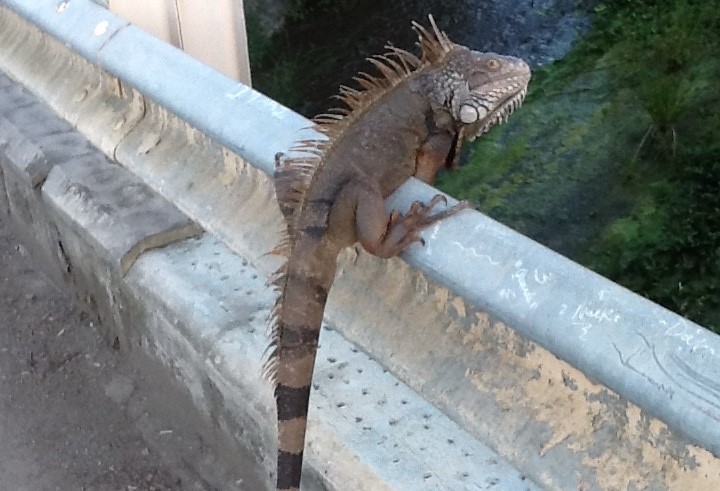DAY OF THE IGUANA: An iguana in St. Croix takes in the view over a culvert near the Pearl B. Larsen Elementary School in Estate Peter.
MIAMI — Growing up on Key Biscayne in the 1970s, Paul Zuccarini had no idea the commonplace green iguanas he loved to chase were as exotic as the tourists that descended every winter.
They were like “prehistoric beasts,” said Zuccarini, who would release his prize captures back into the wild. “If we caught a three- to five-foot iguana, it was like catching a dinosaur.”
Except these dinosaurs have gone the opposite of extinct. Since they first appeared in the 1960s, green iguanas have become as ubiquitous in South Florida as sunshine. They outnumber many native reptiles and thrive along cultivated urban coasts that provide a feast-able landscape of bougainvillea and hibiscus. Just about every golf course, park and retention pond offers perfect habitat for herds of bright green and orange lizards.
While annoying, state officials have until now not taken an aggressive approach. Rangers routinely trapped them, but more intense efforts were saved for a long list of invasive species, like pythons and lionfish, that threatened wildlife and choked native habitat. Iguanas didn’t eat native birds or animals and weren’t moving into protected marshes. A 2010 freeze also helped thin the population. Frozen iguanas literally dropped from trees.
But that’s starting to change, as the number of iguanas and the damage they inflict reach what might be a tipping point.
This month, the Florida Fish and Wildlife Conservation Commission hired a trapper for the first time to focus on managing the population on public land in the Keys. The FWC also started holding workshops on management efforts to show homeowners how to work traps, protect yards and ward off the reptiles.
“We really want to empower people to know what they can do, how we can help folks help themselves,” said Kristin Sommers, FWC’s exotic species coordinator. “FWC can’t go out and remove everybody’s iguanas. That’s just not possible.”
So what changed? Sommers said ‘human conflicts’ increased. Translation: Iguanas that can burrow into sewer lines and under roads began popping up in toilets, showing up at shopping centers, and generally becoming even peskier than usual. In the Keys, they increasingly threaten natural areas already in short supply, gobbling up host plants for some of the state’s disappearing butterflies and damaging seawalls. They could potentially threaten the Keys’ new billion-dollar sewage line. They also like to poop in swimming pools, potentially spreading salmonella.
“The iguanas have been kind of the pink elephant in the room,” said wildlife biologist Joe Wasilewski. “They don’t kill other animals and eat plants, so they’ve been put on the back burner.”
Florida also doesn’t want to become the next Caribbean. In a new position statement issued this month updating their ‘pest status,’ the International Union for the Conservation of Nature said iguanas can now be found throughout the Caribbean, from the Cayman Islands east to St. Lucia, leaving a trail of destruction.
In Puerto Rico, they have been blamed for knocking out power and paralyzing the San Juan airport. In Grand Cayman, officials say the population increased from about 250,000 to more than a million in just three years. They’ve also started mating with native iguanas on Little Cayman, an evolutionary leap that could signal big problems for threatened rock iguanas.
In 2014, the Bahamas National Trust hired Wasilewski to deal with an infestation on a swanky resort island where a pair released less than a dozen years ago led to an infestation. So far, he’s removed nearly 12,000 using traps and snares, grabbing them with his bare hands and even using drones to knock them out of trees.
“The numbers just exploded to where you drive a golf cart and there’s waves of green iguanas going into the forest,” he said. “They’re literally a green plague.”
In Florida, the population is creating a new industry for trappers. Tom Portuallo started Iguana Control in Broward County a decade ago after a trip to a friend’s house in Key West and found a half dozen iguanas clustered around the pool “and all defecating,” he said. “I thought, geez, can’t you do something.”
“I tell them to leave it alone. It’s not worth the expense,” he said.
But if they begin damaging property or fouling pools, he says it’s worth investing in control efforts. How bad can the damage be? A Palm Beach County homeowner once called to complain about iguanas sunning themselves on a new 150-foot-long seawall that the homeowner had installed.
“Usually when I approach, they’ll jump into the water,” Portuallo said. “But when I got close, three jumped into a hole and when I got near, I could hear water.”
The iguanas had burrowed a hole under the new seawall.
At Bill Baggs Cape Florida State Park after this past month’s cold snap, three large iguanas climbed into mangrove trees around No Name Harbor to sun themselves. All three were males, their skin turned to orange, ready to mate. During the season, Wasilewski said females can lay dozens of eggs. Twenty years ago he led a film crew from National Geographic on an iguana hunt in nearby Crandon Park and found a nest with 60 eggs.
As dolphins chased mullet in the boat basin, the iguanas seemed oblivious to them or the construction crews jack-hammering a nearby sidewalk.
“In their native habitat, and they’re in check, their numbers are sustainable and so is everything around them,” said Wasilewski, who spends most of his time working to conserve endangered species, including iguanas in other places. “But unchecked is what’s happening here in South Florida and it’s been happening for years.”




